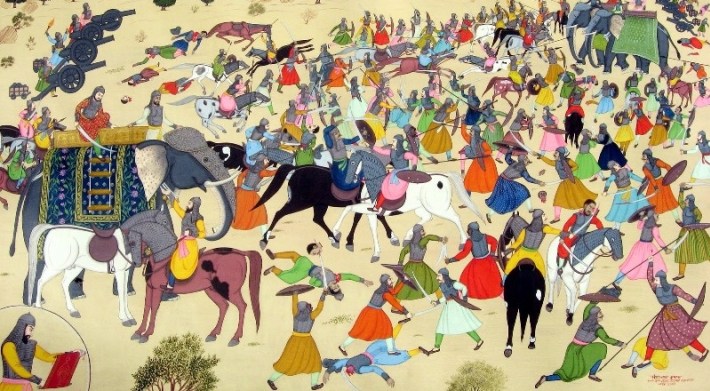Shah Jahan’s empire expansion and war of succession
Other Important Facts-
- Introduction of life of Mughal ruler Shah Jahan
- What was the noorjahan faction
- Important literary sources of medieval Indian history
Shah Jahan’s empire expansion in the south
- Shah Jahan invaded Ahmednagar first in the South and in 1633 AD Winning it in the Mughal empire. And captured the last Nizam Sultan Hussain Shah in the fort of Gwalior.
- Shah Jahan took Fateh Khan, an ineligible son of Ahmadnagar Wazir and Malik Ambar, into the service of the state.
- Shahji Bhosale was in the service of Ahmadnagar earlier, but after the fall of Ahmednagar, he accepted the service of Bijapur.
- After joining Ahmednagar in the empire, Shahjahan put pressure on Golconda.
- Qutubshah, the short-lived ruler of Golconda, attacked the ghosts in 1636 AD. In the treaty with the Mughals.
- As a result of the treaty with Golkonda, Shah Jahan was included on both Khutba and coins.
- The governor of Golkonda has married one of his daughters to Shahjada Mohammed, son of Aurangzeb.
- The Sultan of Golconda (Shia community) removed the name of Shah from Iran and included the name of Shah Jahan. As a result, the tax of 4 lakhs (currency) which was given to Bijapur of Golconda state – was waived.
- Muhammad Sayyed (a Persian merchant who was famous as Mir Jumla) was the wizard of the round swivel and he got angry with some thing and went to the service of the Mughals.
- This same Muhammad Syed (Mir Jumla) had gifted Kohinoor diamond to Shah Jahan.
- Shahjahan was born in 1636 AD. Attacked Bijapur and forced Adilshah I to confer first, consequently Sultan pledged to give Rs 29 million as tax every year.
- In addition, Bijapur gave the fort of Pendendra, Gulbarga, Bijapur and Sholapur to the Mughals and gave the right to the decision of both Golconda’s friendship and conflict to the Mughals.
- At the time of Jahangir 1622 AD Kandhar had left the authority of the Mughals, but the disgruntled ally of Shah Jahan, the al-Qaeda leader, Alamardin Khan, in 1639 AD. This fort was handed over to the Mughals.
- But the disgruntled al-Qaeda leader, Alamdar Khan, was dissatisfied with Shah Jahan’s diplomatic effort. This fort was handed over to the Mughals.
- 1648 AD The fort retreated from the Mughals and after that Mughal Baghasah could never regain power over it.
Shah Jahan tried to take advantage of the clutter of Central Asia, namely Balakh and Badakhshan, but this campaign was unsuccessful and losses of around 40 crores. - In the time of Shah Jahan, Kandahar was finally eliminated from the rights of the Mughals.
The war of succession happened during Shah Jahan
6 September 1657 AD In the Shahjahan’s sick, the war of succession started between his sons. In which his daughters also took the side of some warring princes.
Jahanara Darashikoh, Roshanara took the side of Aurangzeb Murad Baksh. Guhanarara took the side of Aurangzeb and Murad Baksh. This terrible battle (left without rebellion) for the throne, while the survival of the enemy, was the first example of Mughal history.
Firstly in Shah Shuja Bengal and Murad, he declared himself an independent emperor in Gujarat, but Aurangzeb did not announce his independence for diplomatic reasons.
In order to take part in the war of succession, Shah Shusa first came in January, 1658. Traveled towards the capital in.
The war of succession began with the Shahshuja and the royal army (under the leadership of Suleiman Shikoh, and Jaisingh), 5 km from Benaras. Far away from the war of Bahadurpur, in which defeated Shuja ran east.
At the place named Dharamt, 14 miles from Ujjain, the accusations of Aurangzeb and Muradbakhsh were fought with the army under the leadership of Jaswant Singh and Qasim Khan. In which the royal army was defeated. In the war, the behavior of the Qasim Khan of the royal army was a doubtful parent.
When Jaswant Singh returned to Jodhpur after defeating in the battle of Dharamt (April 14, 1558 AD), his queen did not let them enter the fort in the crime of fleeing from the war zone.
Rivalry of the Rani army of Aurangzeb and Murad was fought on May 29, 1658. There was a place called Samugarh. This war was with the royal artillery.
The main reason for Dara’s defeat in the battle of Samudhgarh – Muslim betrayal of the chieftains and Aurangzeb’s diplomacy was taken prisoner and later he was assassinated.
The war between Aurangzeb and Shuja took place on January 5, 1659, in the valley of Goddess near Ajmer, in which Dara was finally defeated. In which, Shuja Arakan ran away, where he died.
Last fight between Aurangzeb and Dara was April 1659 AD. In the valley of Devarai near Ajmer, in which Dara was finally defeated.
The agreement which was made between Aurangzeb and Muradbakhsh In it, Dara was called Rais-El-Mulihida (i.e. upright princess).
Dara was given the death penalty by a court of judges.
Dara’s body was rotated on the streets of Delhi and finally brought to Burma in Humayun’s Tomb.
This was an eyewitness testimony of this insulting-man behavior with Bernier Dara. He wrote that – “There was huge gathering; everywhere I saw people weeping and mourning at Darius’s fate.”
Reference:https://www.indiaolddays.com/





